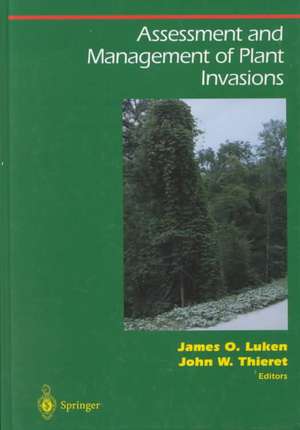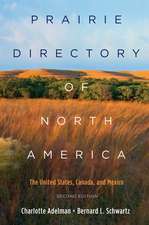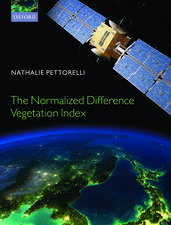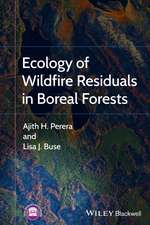Assessment and Management of Plant Invasions: Springer Series on Environmental Management
Editat de James O. Luken, John W. Thiereten Limba Engleză Hardback – 3 ian 1997
| Toate formatele și edițiile | Preț | Express |
|---|---|---|
| Paperback (1) | 1221.38 lei 6-8 săpt. | |
| Springer – 27 sep 2012 | 1221.38 lei 6-8 săpt. | |
| Hardback (1) | 1230.84 lei 6-8 săpt. | |
| Springer – 3 ian 1997 | 1230.84 lei 6-8 săpt. |
Din seria Springer Series on Environmental Management
- 15%
 Preț: 642.18 lei
Preț: 642.18 lei - 18%
 Preț: 1236.51 lei
Preț: 1236.51 lei - 18%
 Preț: 953.82 lei
Preț: 953.82 lei - 18%
 Preț: 779.08 lei
Preț: 779.08 lei - 15%
 Preț: 642.83 lei
Preț: 642.83 lei - 15%
 Preț: 677.85 lei
Preț: 677.85 lei - 15%
 Preț: 640.06 lei
Preț: 640.06 lei - 15%
 Preț: 640.06 lei
Preț: 640.06 lei - 15%
 Preț: 635.47 lei
Preț: 635.47 lei - 15%
 Preț: 505.49 lei
Preț: 505.49 lei - 18%
 Preț: 1236.69 lei
Preț: 1236.69 lei - 18%
 Preț: 962.98 lei
Preț: 962.98 lei - 15%
 Preț: 640.06 lei
Preț: 640.06 lei - 15%
 Preț: 638.24 lei
Preț: 638.24 lei - 15%
 Preț: 634.68 lei
Preț: 634.68 lei - 18%
 Preț: 959.82 lei
Preț: 959.82 lei - 15%
 Preț: 641.03 lei
Preț: 641.03 lei - 15%
 Preț: 653.46 lei
Preț: 653.46 lei -
 Preț: 399.50 lei
Preț: 399.50 lei -
 Preț: 387.38 lei
Preț: 387.38 lei - 18%
 Preț: 950.66 lei
Preț: 950.66 lei - 15%
 Preț: 651.99 lei
Preț: 651.99 lei - 18%
 Preț: 957.62 lei
Preț: 957.62 lei - 15%
 Preț: 647.40 lei
Preț: 647.40 lei - 18%
 Preț: 945.79 lei
Preț: 945.79 lei - 18%
 Preț: 1218.69 lei
Preț: 1218.69 lei - 15%
 Preț: 634.68 lei
Preț: 634.68 lei - 18%
 Preț: 1225.79 lei
Preț: 1225.79 lei - 15%
 Preț: 657.25 lei
Preț: 657.25 lei -
 Preț: 397.38 lei
Preț: 397.38 lei -
 Preț: 404.89 lei
Preț: 404.89 lei - 15%
 Preț: 641.03 lei
Preț: 641.03 lei - 15%
 Preț: 650.86 lei
Preț: 650.86 lei - 15%
 Preț: 711.21 lei
Preț: 711.21 lei - 15%
 Preț: 643.16 lei
Preț: 643.16 lei - 18%
 Preț: 724.80 lei
Preț: 724.80 lei - 15%
 Preț: 635.47 lei
Preț: 635.47 lei
Preț: 1230.84 lei
Preț vechi: 1501.03 lei
-18% Nou
Puncte Express: 1846
Preț estimativ în valută:
235.55€ • 245.01$ • 194.46£
235.55€ • 245.01$ • 194.46£
Carte tipărită la comandă
Livrare economică 14-28 aprilie
Preluare comenzi: 021 569.72.76
Specificații
ISBN-13: 9780387948096
ISBN-10: 0387948090
Pagini: 324
Ilustrații: XIV, 324 p.
Dimensiuni: 178 x 254 x 22 mm
Greutate: 0.82 kg
Ediția:1997
Editura: Springer
Colecția Springer
Seria Springer Series on Environmental Management
Locul publicării:New York, NY, United States
ISBN-10: 0387948090
Pagini: 324
Ilustrații: XIV, 324 p.
Dimensiuni: 178 x 254 x 22 mm
Greutate: 0.82 kg
Ediția:1997
Editura: Springer
Colecția Springer
Seria Springer Series on Environmental Management
Locul publicării:New York, NY, United States
Public țintă
ResearchCuprins
SECTION I. Human Perceptions.- 1. Defining Indigenous Species: An Introduction.- 2. Defining Weeds of Natural Areas.- 3. Potential Valuable Ecological Functions of Nonindigenous Plants.- SECTION II. Assessment of Ecological Interactions.- 4. Documenting Natural and Human-Caused Plant Invasions Using Paleoecological Methods.- 5. Community Response to Plant Invasion.- 6. Impacts of Invasive Plants on Community and Ecosystem Properties.- 7. Animal-Mediated Dispersal and Disturbance: Driving Forces Behind Alien Plant Naturalization.- 8. Outlook for Plant Invasions: Interactions with Other Agents of Global Change.- 9. Experimental Design for Plant Removal and Restoration.- 10. Response of a Forest Understory Community to Experimental Removal of an Invasive Nonindigenous Plant (Alliaria petiolata, Brassicaceae).- SECTION III. Direct Management.- 11. Management of Plant Invasions: Implicating Ecological Succession.- 12. Methods for Management of Nonindigenous Aquatic P] ants.- 13. Biological Control of Weeds in the United States and Canada.- 14. Prioritizing Invasive Plants and Planning for Management.- SECTION IV. Regulation and Advocacy.- 15. Prevention of Invasive Plant Introductions on National and Local Levels.- 16. Exotic Pest Plant Councils: Cooperating to Assess and Control Invasive Nonindigenous Plant Species.- 17. Team Arundo: Interagency Cooperation to Control Giant Cane (Arundo donax).- 18. A Multiagency Containment Program for Miconia (Miconia calvescens), an Invasive Tree in Hawaiian Rain Forests.- Appendix: Selected Plant Species Interfering with Resource Management Goals in North American Natural Areas.- References.










